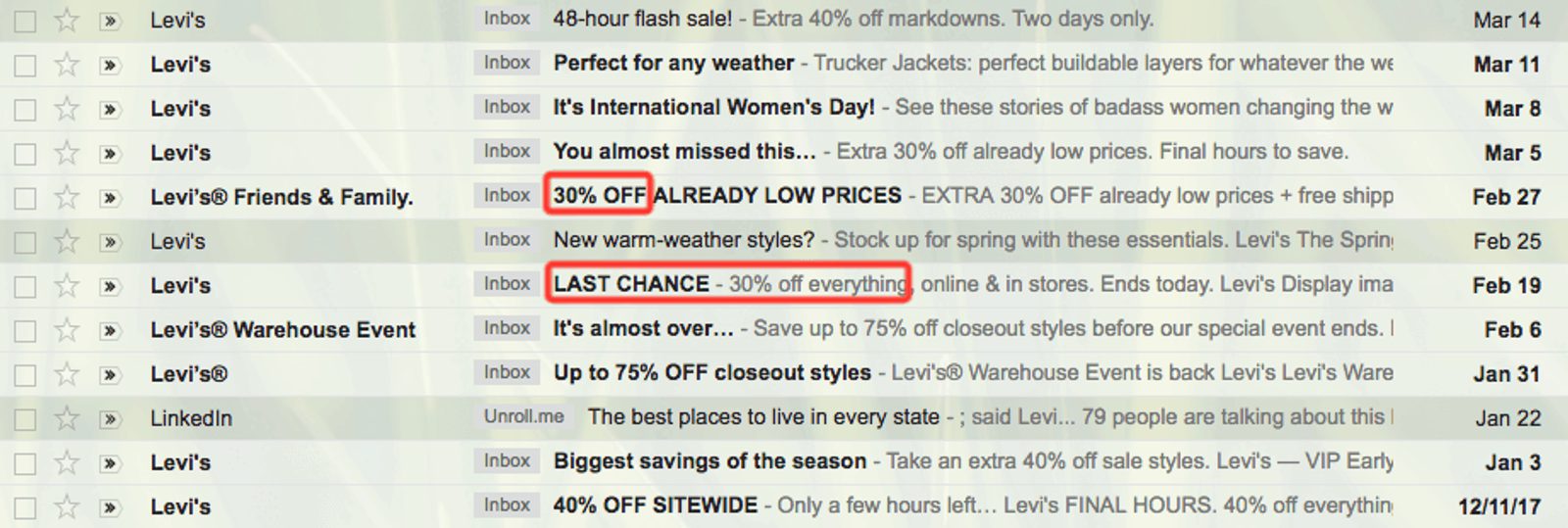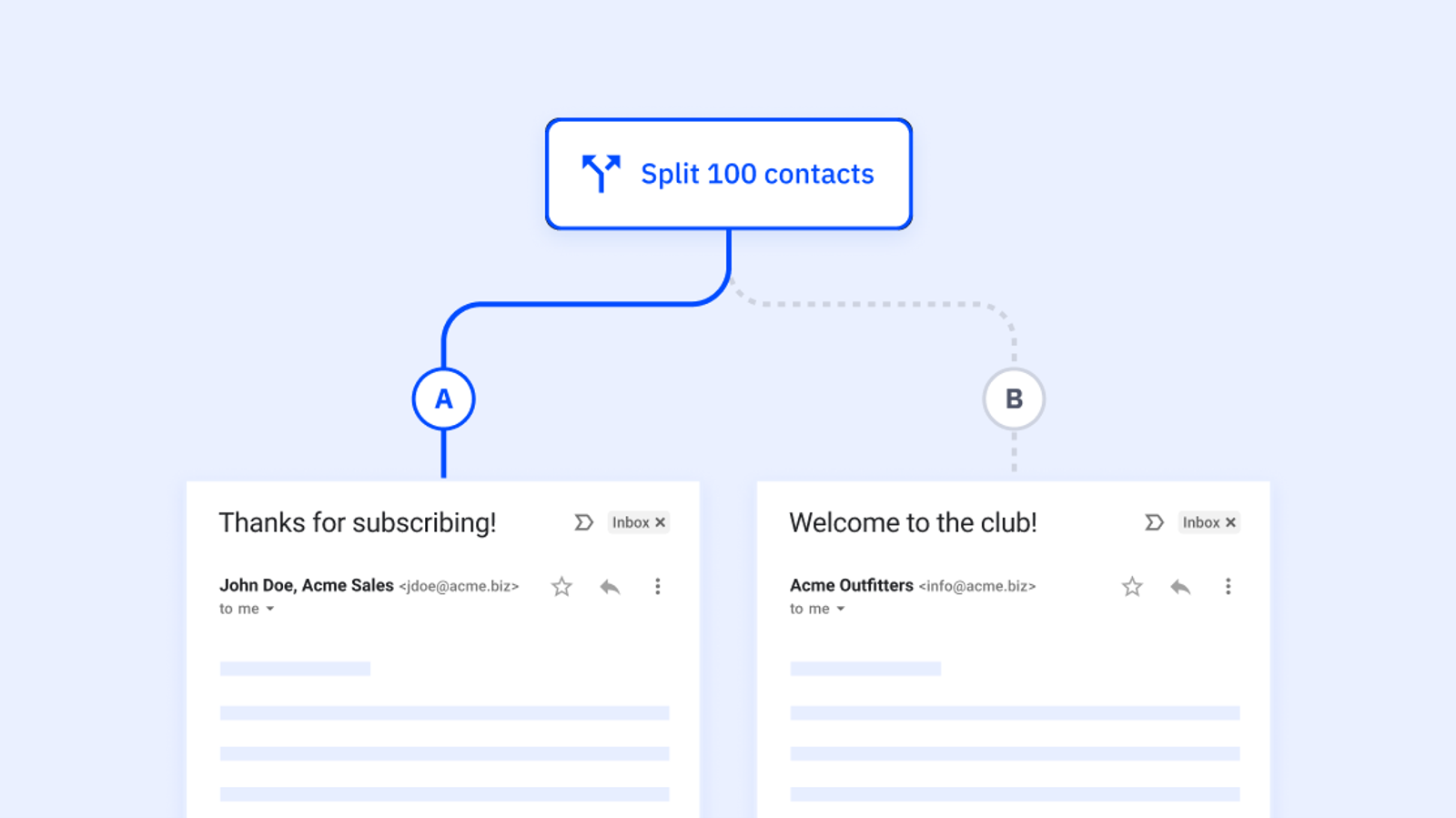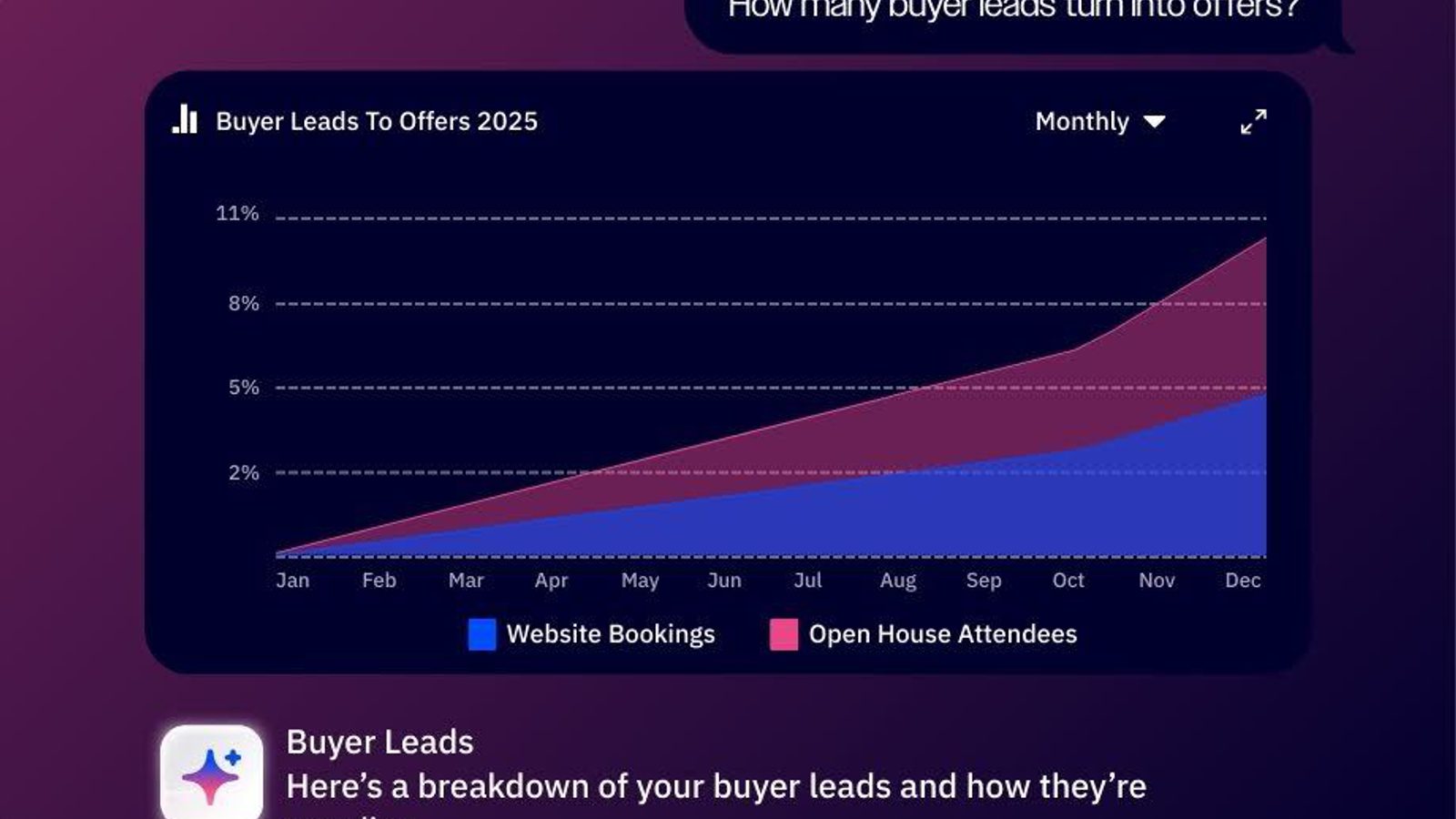Have you ever had an email with an open rate of 104 percent?
Wait, is that even possible? How can you have an open rate higher than 100?
I have yet to achieve the mythical, 100+ percent open rate (my best is a unique open rate of 82%), but it is possible to do. If you’re tracking total opens instead of unique opens, if a ton of people open your email multiple times and forward it to their friends...you can record an open rate above 100%.
But the most incredible thing about a 104% open rate email—which is real, and was written by copywriter Joanna Wiebe—isn’t the sky-high open rate.
It isn’t even the sky-high conversion rate of the funnel as a whole.
It’s the fact that the email was almost never sent at all.
As Joanna recounts in a talk for the Business of Software, she expected the email to be a flop. The tone of the email made her uncomfortable, and she was seconds away from deleting it—until she looked at the analytics.
On a list of thousands and thousands of people, this email was most definitely pulling its weight (unique opens were also high, in the high 80s).
But without the data, it would have disappeared.
And without the lessons learned from A/B testing, it never would have been successful in the first place.
A/B testing subject lines helps people listen to you
Your email open rate is affected by lots of factors. Deliverability, from name, time of day, and preheader text are all important—but no factor is quite as important as your subject line.
Your email subject line is what draws people in. It’s where you have the chance to grab attention and force people to click with the power of curiosity.
It’s what gets people to listen.
On a list of 10,000 people, an open rate of 20% gets you 2,000 readers. If you can bump that up to 25%—which is possible with a great email subject line—you’ve earned another 500 readers.
Even at a meager 1% conversion rate, that’s 5 new customers.
All of that, from changing the subject line of one email. What if you could write better subject lines for every email?

Picking winning subject lines is difficult, but A/B testing makes it a whole lot easier.
A subject line test is simple: You send the same email to small portions of your list. Look to see which group opened your email more often, then send the winning subject line out to everyone.
Can it get more complicated than that? Of course.
You can:
- Test subject lines against multiple different variants, such as subject line length
- Adjust the size of your email list that you use to test subject lines
- Wait longer before choosing the winner
- Judge the winner based on click-through rate instead of open rate
All of that is worth doing—eventually. But you don’t need to start with a super complicated split testing.
Early on, it’s enough to run simple A/B subject line tests. One subject line vs another. Mano a mano. A duel to see which subject line is the most enticing.
A/B testing email subject lines is easy, from a technical standpoint. Just a few button clicks.
The much harder question is...what should you test?
When you A/B test subject lines, it’s easy to come up with a sentence to throw at the test. It’s a lot harder to come up with a test that you can learn from—and make all of your future subject lines better too.
Here’s the simplest email A/B testing you can find
This article will help. We’ll walk through the fundamentals of great email subject lines, show off which tests to run, and give you some templates that you can steal to use right away.
You’ll learn
- The psychology of curiosity, and the mistake most subject lines make (but yours can avoid)
- How to pinpoint the emotions you want to create in your audience
- Tests you can run in your next email
- Exact subject line templates you can steal (and examples of them in use)
We’ll start by talking through a pair of powerful fundamentals.
Why? Because even though testing is important (and the best way to find the best email subject lines), you can skip huge frustrations by learning from those who came before.
The Curiosity Gap and the power of strong emotions
In 1994, Carnegie-Mellon professor George Loewenstein published an extraordinary paper with a mundane title: The Psychology of Curiosity.
In the paper, Loewenstein proposed the “information-gap theory” of curiosity. I’ll spare you 25 pages of dense psychology writing and give you the short version—we (humans) are curious when there’s a gap “between what we know and what we want to know.”
Curiosity, in turn, makes us take action to find answers.
Stepping back into the world of marketing, your email subject lines will be enormously more effective if they can make people curious.
And yet…
Too many marketing emails don’t bother with curiosity. Instead, they make a mistake that’s killing their open rates (and might be killing yours).
Summarizing.
Your subject line should not summarize the content of your email.
This is so important that I want to say it again: your subject line should not summarize the content of your email!
Imagine your email has landed in someone’s inbox. They’re checking for new messages and see your subject line. This is it—the moment of truth.
But your subject line gives them all the information they need. It tells them exactly what to expect from the email, so they don’t bother to open your message (and certainly don’t click). They’d much rather read through the pun chain going on in the latest reply-all.
Instead of telling people exactly what to expect, get them curious.
The biggest rule of email subject lines? Tease, don’t tell.
Expert Insight: Rob Marsh on getting opened

“Remember the purpose of a subject line is to get the email opened.
Just about everyone will open an email from their mom or their friends—regardless of the subject line—because we have a relationship with these people.
But emails from businesses or someone we don’t have a personal relationship with? The subject lines on those emails need to give us a reason to open them.
They need to create curiosity. Or pique our interest. What they shouldn’t do is make a pitch. A subject line won’t make the sale, so don’t try. They simply exist to get the email opened.
Then you hit them with brilliant copy that agitates the pain they feel and intensifies the need for the product/service/message you have to share.”
– Rob Marsh is a conversion copywriter and marketing strategist who works with health, tech, and SaaS companies to tell their brand stories. He writes at BrandStory and runs The Copywriter Club podcast.
Loewenstein lists 5 ways that you can create curiosity.
- A curiosity-inducing question
- A sequence of events that is left unfinished (with an unclear outcome)
- A violation of expectations
- When someone else has information we are lacking
- When we used to have information that we’ve since forgotten or lost
Let’s take a look at an example, so you can see this in action. Which of these is the most compelling?
- How to earn half a million dollars a year
- How can you earn half a million dollars a year?
- Do you have the courage to earn half a million dollars a year?
Right off the bat—it isn’t number one.
Number one makes a big claim, and it summarizes. If you saw that in your inbox, you’d probably dismiss it as a scam or exaggeration from some marketer.
Number two is a bit better. It’s still a bit over the top, but it at least asks a question. Still, it doesn’t really violate expectations. And even though it implies I have information you don’t, it makes that information seem unbelievable.
But number three…
Number three was written by legendary copywriter Eugene Schwartz, as the headline of a mail-order advertisement for a book on investing (old-school headlines and email subject lines have a lot in common).
Schwartz has added another one of Loewenstein curiosity-inducers—violated expectations. When I read that headline, I’m no longer thinking about the over-the-top claim ($500,000 per year). I’m actually asking myself if I have courage.
Which brings us to the next point—strong emotions.
Expert Insight: Laura Belgray on intimacy

“What will pop out from all the other businessy-looking garbage in your subscribers’ inbox, and what will feel most “me to you” intimate?
When it’s a really important email, I’ll send myself a test to see how the subject line looks on my phone — and how much of it shows up. The first words are the most important, because the rest is often cut off.”
– Laura Belgray is a copywriter and founder of Talking Shrimp. You can learn how to write high-converting emails with her guide to subject-line writing.
Gary Bencivenga, perhaps the greatest living copywriter, has this to say about the power of emotion in advertising.
“The vast majority of products are sold because of the need for love, the fear of shame, the pride of achievement, the drive for recognition, the yearning to feel important, the urge to look attractive, the lust for power, the longing for romance, the need to feel secure, the terror of facing the unknown, the lifelong hunger for self-esteem and so on.
Emotions are the fire of human motivation, the combustible force that secretly drives most decisions to buy. When your marketing harnesses those forces correctly you will generate explosive increases in response.”
A subject line like “Do you have the courage to earn half a million dollars a year?” gets me thinking. Do I? Or maybe even “You bet I do!” Either way, I’m going to keep reading.
Research from Wharton professor Jonah Berger shows that emotions can play a powerful role in how people interact with content.
After analyzing over 7,000 New York Times articles, Berger found that emotion affected content sharing. You’ll often hear this study cited by marketers as saying that “positive emotions lead to more shares than negative emotions.” And it’s true the study found that to be the case, on average.
The much more interesting result is that high-activation emotions led to more sharing.
In other words, some emotions are actually motivating—and they motivate us to take action.
Amusement. Anger. Awe. Joy. Relief. Frustration. Fear. Challenge.
If you can activate an emotion like one of those with your subject line, you can bet you’re going to get more people to open your emails.
Do you have the courage to add strong emotions to your subject lines?
Expert Insight: Justin Blackman on the subject line’s “job”

“For subject lines, you’ve got to factor in the voice of the sender, the content of the email, what else is in the reader’s inbox, and what value you provide. If you’re pitching a sale, you may find that simply putting “SALE” in big letters is all you need.
But overall, you just need to create a liiiiiiittle bit o’ curiosity. Don’t try to make your subject line do everything. It’s only job is to entice the reader into opening the email. Not do the heavy lifting.”
– Justin Blackman is a copywriter and creator of the Headline Project, where he wrote 100 headlines a day for 100 days. You can learn more on his website.
4 ways to test your email subject line
You can always test any subject line against any other subject line.
But when the dust clears and the winning subject line turns to see if the loser should live or die (gladiator-style), what will you have learned for the next time?
Here are four types of A/B tests you can run for your subject lines.
1. Clever vs. Your value proposition
Is it better to be clever or clear?
Usually, I’m a firm advocate of clarity—it’s hard to sell things if people don’t know what you’re selling.
But when it comes to subject lines, the line is blurry. You should certainly still be clear in the body of your email...but is clarity going to get people to click?
Sometimes it’s easier to induce curiosity by being clever.
On the other hand, cleverness has its risks. And a value proposition has the benefit of being simple.
- The danger of clever: I don’t understand why your email is worth reading, so I ignore it
- The danger of value prop: I don’t think the value prop you’ve stated applies to me, it’s boring, or I don’t believe that you can deliver it
Expert Insight: Laura Belgray on curious vs specific promises

“I like to test a mysterious, curiosity-provoking line against a specific, “here’s what this is about” line. For a GDPR engagement email, I tested “They’re going to take you away” vs “1 humiliating nugget, 1 copywriting tip”
The first one (mysterious and fraught) won by nearly double the open rate of the other (specific promise).”
– Laura Belgray is a copywriter and founder of Talking Shrimp. You can learn how to write high-converting emails with her guide to subject-line writing.
I recently sent a set of two emails to readers of my personal website. See if you can guess the winning subject line for each.
Email 1: Delivered a blog post about what to do when you don’t feel like working out.
- Subject Line A: For when you don’t feel like working out
- Subject Line B: Charles Mingus, chains, and exercise
Email 2: Delivered a blog post about the mental health benefits of exercise.
- Subject Line A: Meditation, exercise, and...magic?
- Subject Line B: For when you worry all the time
Bets are in? No more takers? Are you sure you don’t want to change your mind?
Then here are the results.
In both cases, subject line A won in a landslide. Like whoa. In the first email, subject line A also boosted click-through rate to just over 6%.
Why?
Expert Insight: Sophia Le on curiosity vs. utility

“I like to use Dan Pink's framework for subject lines - curiosity vs. utility. Curiosity works great for opens (Things like 'New!' or using a name in the subject line), but the novelty can wear off if you're using it constantly.
Utility forces you to understand what is important and necessary to the persona you're writing to (Things like 'Meeting recap' or 'Sales funnel automation').”
– Sophia Le helps SaaS companies grow their customer relationships with email. You can get her fill-in-the-blank email templates on her website.
In retrospect, I can try to piece together what happened. “I don’t feel like working out” is a more specific pain point than “worrying all the time.” The ellipses and question mark in “...and magic?” might have built some additional suspense and curiosity.
Next time, I might try rewriting the Mingus subject line to be more suspenseful. "Exercise and...chains? AND Charles Mingus?" is a bit weird, but it also seems more curious than a simple list.
And who knows? Maybe people just don’t know who Charles Mingus is.
The point is, I definitely have some new ideas of what to test.
At the same time, I don’t think I would have accurately called the winner of each test. Or at least—if I ran tests like this for every email, I don’t think I would be able to pick the winner every time.
That’s what makes testing so valuable.
2. Long vs. Short
Email subject lines should be short, right?
Not necessarily.
In truth, I haven’t seen any compelling numbers either way.
Sure, there’s lots of data out there that seems to study the impact of subject lines. But if you dig through all of it, you find a lot of contradictions—study X showed long subject lines do better, study Y favored short ones, and study Z didn’t find a difference at all.
You might find advice out there like “keep your subject line between 45 and 55 characters.” You might even see people talk about the pixels of your subject line (for mobile compatibility).
But what really matters is what works for your audience.
If you sell to people you mostly open business email on their laptops, formatting your subject line for mobile is less important than getting those desktop users to open.
If you have a quirky brand that your readers uniquely love, maybe an all-emoji subject line can actually work for you.
And maybe people are so used to getting 45 to 55 character subject lines that it makes sense to break the pattern.
The point is, this is another difference worth testing.
- The danger of long: Might get truncated by email providers and sometimes can be rambly.
- The danger of short: Not enough space to be interesting
Literally. as I wrote the previous sentence, I got an email from copywriter and psychology expert Margo Aaron with the subject line “Why bother.” Just like that, all lowercase.
I opened it.
Expert Insight: Justin Blackman on testing

“I usually dip my toes into 2 different ponds when testing. Sometimes it’s a positive vs. negative angle (Get X to be happy! vs. Your life will be terrible and your teeth will fall out if you don’t get X!).
Other times it’s short vs. long. Compare your professional emails to your personal ones. Work lines tends to lean toward ‘Follow up question to our earlier discussion about platypuses’ whereas that same email to a buddy will be ‘QQ’ (quick question) or maybe even ‘hey.’”
– Justin Blackman is a copywriter and creator of the Headline Project, where he wrote 100 headlines a day for 100 days. You can learn more on his website.
3. Questions vs. Statements
A curiosity-inducing question is one of Loewenstein’s 5 ways to create curiosity. But do questions always win?
Maybe.
A great question is a great way to induce curiosity. Still, sometimes it’s hard to come up with a really good question to introduce the subject of your email.
Other times a question just isn’t interesting enough. I ignore just about every email that starts with “How can you get more blog traffic” or something similar—because everyone uses boring questions like that.
There aren’t really any dangers of using questions vs statements—except that if you don’t A/B test them you could wind up with lower open rates.
Whenever you test questions, remember to use some of Loewenstein’s other methods too. Combining questions with the other elements can give you even more curiosity. Try to:
- Break expectations (aka, don’t sound like everyone else)
- Use strong emotions
If you decide to test a statement, you can use a curiosity-inducer that’s harder to do with questions—unfinished stories.
I’ve used subject lines like “If you have trouble working out, blame your cousins” and “I dropped a barbell on my face” to great effect. Both outperformed the question-based subject line they were up against.
4. Personalization vs. No personalization
There I was, minding my own business reading on my Kindle in a coffee shop on a quiet Saturday.
Suddenly, my attention was wrenched away from the words on the page. I spun around wildly, searching for the person who said…
Who said…
My name!
Sorry to be dramatic. It was just an old coworker who had recently moved to the area—nothing to be alarmed about. I had fallen victim to the cocktail party effect.
The idea of the cocktail party effect is that you’re more likely to notice your own name. If you’re in a crowded room, like at a cocktail party (or coffee shop), your brain filters out most of the conversation happening around you.
Until someone says your name. Then you perk up and pay attention.
You can take advantage of the power of names in your email subject lines.
Joanna Wiebe of Copy Hackers writes some lovely headlines. And every so often, she’ll throw in some personalization.

That’s me!
Personalization is a great way to stand out in a crowded inbox. You can use names, geography, or other info to personalize your subject lines.
- The danger of personalization: It gets creepy if you overuse it, like a salesperson who says your name too much
- The danger of no personalization: You miss out on opens because you sound generic
Remember—a lot of people don’t realize how much information you have about them. Test personalization to find the right balance of personal and creepy.
Setting up a split test is simple—it takes just a few extra clicks to try out a different subject line. You can read our help documentation to learn more about how to set up a split test in ActiveCampaign.
With some ideas of what kinds of email subject lines to test...let’s give you some templates to play with.
Subject line examples, formulas, and templates you can steal
Want to know a secret? The best email copywriters don’t write from scratch.
Sure, every so often you’ll come up with a fun, creative idea that no one has done before. But if you can learn from what other people have done, why wouldn’t you?
There are over 269 billion emails sent every day. Before email was a thing, copywriters were writing headlines with the same goal as subject lines—get people to keep reading.
I won’t belabor the point. Templates and formulas are a great place to start your email copywriting. You can always branch out if something shiny and new and creative catches your eye—in fact, coming up with a bunch of different subject lines helps you get better ideas.
Expert Insight: Neville Medhora on subject line ideas

“I tend to always write out 4 different subject lines for each email, because it's way less pressure to write 4 rather than just one. My process works like this:
Subject 1: Super matter-of-fact subject just explaining what's gonna be inside.
Subject 2: Use an example result.
Subject 3: Use a number.
Subject 4: Be fun and a bit wacky.
Here's an example of this process in action. Let's assume the email is about: Email Topic: How to get higher open rates on your email
I would write out several different subject lines like this:
Subject 1: Higher email open rates
Subject 2: I tripled email opens on Active Campaign like this....
Subject 3: My email opens went from 14% to 39% with this
Subject 4: Holy crap my email open rates just shot up!”
– Neville Medhora is a copywriter and founder of KopywritingKourse. He is an advisor with Sumo, and his words have been read by over 120,000,000 eyeballs.
I’ll run through these templates quickly—just the formula, a couple of notes, and any notable examples.
You’ll also see some top copywriters chime in with their personal favorite subject lines.
Here’s to [type of person]
“You seem like the type of person who [insert positive attribute.]”
People like it when you finish that sentence with a positive attribute because they like to think that they’re good, successful people.
This was most famously used by Apple as part of their Think Different campaign: “Here’s to the crazy ones.”
More recently, Hornitos Tequila used this formula in “Here’s to the shot takers.”
Here’s to [benefit of your solution]
Similar to the above, this is a simple way to highlight a benefit of your product or solution.
For example:
- Here’s to easier time tracking
- Here’s to more blog traffic
- Here’s to clearer skin
The fastest way to [achieve benefit]
A variant on value prop headlines, this template emphasizes speed. People don’t want things next year, they want them now!
A lot of strong subject lines use this template. My only word of caution is to avoid overdoing it—and make sure you don’t use it in a niche that’s prone to overblown claims. More specific benefits usually do better.
Examples:
- The fastest way to grow your email list
- The fastest way to get six-pack abs
- The fastest way to fall asleep at night
[Do activity] like [famous person]
Does your niche have an icon? Consider using this formula.
This formula promises a specific skill set by attaching you to an authority figure. It’s also a subtle way to signal that you’re in a specific niche, if you’re talking about someone that people outside your niche wouldn’t know.
Again, specificity is your friend. “Play chess like Magnus Carlsen” (the world champ) is unbelievable. “Play rook-pawn endgames like Magnus Carlsen” is more compelling.
Examples:
- Fashion sense like Kim Kardashian
- Make half-court shots like Steph Curry
- Rank in Google like Andy Crestodina
Get rid of [problem] once and for all
For some reason, “get rid of [problem]” is less compelling than “get rid of [problem] once and for all.”
Maybe because it’s more energetic. Maybe because a big promise makes the claim easier to believe (e.g. “It might not work forever, but it must work at least a little”). For whatever reason, this one works—although again, it works more with more specific problems.
Examples:
- Get rid of dry skin, once and for all
- Get rid of annoying timesheets, once and for all
- Get rid of tired mornings once and for all
For when you [experience problem]
Another classic—and one that I’ve already referenced earlier in this article. This one sounds less like a marketing claim and more like you giving over some valuable product or information, which can make it work especially well for problems that are frequent but not constant.
Examples:
- For when you don’t feel like working out
- For when your in-laws Just. Won’t. Leave.
- For when your emails don’t get opened
The [famous person] of [category]
Need to explain a concept quickly? Use a simple analogy.
You can use this to explain your service (e.g. “It’s like Windex but for laptops”) or to make an exaggerated claim about your skills—without having it seem exaggerated (e.g. “I’m the LeBron James of carpet cleaning”).
If you choose the second category, it usually works better with a weirder comparison. Also, it works better if the celebrity is known for something specific, rather than being generally famous
The [weird name] technique to get [benefit]
A classic curiosity creator. Give a new name to some technique, then use it as your subject line.
For example:
- The “Fuzzy Dice” Secret For Exploding Your Sales (written by Gary Bencivenga)
- Negotiate the salary you want with the Briefcase Technique (written by Ramit Sethi)
[Challenge]
If you dare someone to do something, they often will.
Here are three examples of this in action:
- Can you pick the winning headline? (Gary Bencivenga)
- Order form quiz—can you guess the winner? (Ramit Sethi)
- How self-aware are you? (Mark Manson)
Expert Insight: Laura Belgray’s favorite subject lines

Subj: Screw bitcoin, Benyamin - let’s cash in on EMAIL instead! (21 ways to do yours better)
This was sending to a post of roughly the same title.
Why I like it: First of all, it got a 57% open rate cumulative (re-sent to unopens). That’s one of the highest ever sent to my whole list.
Second, I think it has it all: A timely, fraught beginning ("screw bitcoin” leveraged that moment’s frenzy over crypto and collective worry about whether we’d all missed the boat); use of personalization (I do this sometimes in the subject line, not all the time) and a specific promise of information.
Second favorite:
Subj: Dork
I wrote it in a panic after sending an email with no link. I hate screwups like that, and wrote right away that I’d screwed up. HUGE open rates. Especially for a second email in a row.
– Laura Belgray is a copywriter and founder of Talking Shrimp. You can learn how to write high-converting emails with her guide to subject-line writing.
The uncomfortable truth about [topic]
“The uncomfortable truth” is a great phrase because it implies a secret (curiosity-activator number 4) without actually coming right out and saying it.
This one is especially useful when it introduces a story about your personal experience.
Examples:
- The uncomfortable truth about startups
- The uncomfortable truth about losing friends
- The truth about working from home (Margo Aaron)
The secret to [result]
The result here needs to be small and specific enough to make there being a “secret” to it believable. “The secret to growing a business” feels scammy because the promise is too big.
Examples:
- The secret to clear skin
- The secret to kids that behave in public
- The secret to falling asleep at night
[Provocative question]
Questions are powerful, if you do them well.
Your question needs to be specific and it needs to have an answer. This is not the time to get dramatic.
The point of this is to ask a very specific question that your audience wants an answer to—and then answer it with a definitive, very specific answer. Otherwise people are going to leave disappointed.
Examples:
- Do buzzwords work in emails? (Val Geisler)
- What would change in your life (or job) if you did X 10,000 times? (Joanna Wiebe)
- Could a quiz be your next huge lead magnet? (Joanna Wiebe)
Expert Insight: Margo Aaron’s favorite subject line

"You want your emails to sound like a friend is writing to a friend – how would you write the subject line if this was going to your mom or coworker?
[My favorite subject line is] 'hold up' (see screenshot below) because it had a 50% open rate and 0 unsubscribes - which I didn't even know could happen!!"

– Margo Aaron started her career as a psychology researcher, then transitioned to become a digital marketing and copywriting expert. She runs a virtual coworking space called The Arena.
[Thing] = [Thing that it shouldn’t equal]?
Setting up a comparison that doesn’t make sense opens up a curiosity gap. Your reader wants to know how the two things are related—so they click.
Joanna Wiebe used this to promote a recent blog post on Copy Hackers. “Wedding invitations = copy?” was her subject line.
I used this recently in cold outreach emails, to get quotes for a blog post I was researching. My subject line was “This post = entrée. Your advice = ...seasoning?”
Expert Insight: Justin Blackman’s favorite subject line

“My favorite subject line was for a loyalty promotion offering 2x points on all purchases. The audience was big on their earnings and I was given about 30 minutes to whip up an email for about 2 million people.
I kept it short, sweet, and a lil’ funny with the subject line, “What’s better than points? Double points!” Not only was it the highest performing email of the campaign, but 2 years later, it was swiped verbatim by a competitor.”
– Justin Blackman is a copywriter and creator of the Headline Project, where he wrote 100 headlines a day for 100 days. You can learn more on his website.
How to [achieve result]
This formula can work. But it’s also been written about by eeeeeevvvvveerrryyyyone. So it’s overused.
To use this effectively: make the result extremely specific and give an extremely specific way to achieve it in your email
Examples:
- How to make the perfect omelette—and why it MATTERS (John Romaniello)
- How to know what dance to learn (Sarah Jones)
- How to start a business when you’re tired (Ramit Sethi)
- How to actually meet someone at a party (Camille Virginia)
How [famous example] achieves [result]
This is a subject line formula and an idea for content. A breakdown of what makes successful people successful usually performs well.
Examples:
- How HBO keeps making hit shows (Ramit Sethi)
- How Netflix became a $100 billion company in 20 years (Hiten Shah)
This might be the best way to [achieve result]
The “might be” is clever in this one. It makes the subject line seem less like a claim and more like something you came across and want to share.
Example:
- This might be the best way to use social media (Andy Crestodina)
Why [good thing] is [not good]
Take a stance and say something controversial. Controversy opens a curiosity gap.
Just make sure that you actually address the controversy. If you conclude that “good thing” is actually “good” after all, it makes your subject line seem like clickbait.
Examples:
- Why avocados are thumbs down (John Romaniello. He actually used emojis)
- Why star workers make bad bosses (LinkedIn)
Conclusion: Increase your open rates with great content
The path to sky-high open rates starts with great subject lines. And you get great subject lines by learning the fundamentals and testing.
Expert Insight: Laura Lopuch on relevance

“You must be relevant to your reader AND create a curiosity gap. Imagine you're in their shoes: What do they want? What's relevant to them? How can you help them achieve that? Write that down.
Now for that curiosity gap: Remove the noun from your sentence and replace it with "this" or "that." Meet your subject line. Or rephrase your sentence into a question, specifically one that sounds like a question that your friend would ask. Boom: that's your subject line.”
– Laura Lopuch is an email marketing and copywriting expert who works primarily with SaaS companies. You can learn more about her work on her website.
But after you’ve gotten someone to open your emails, you need to get them to keep reading.
The companies with consistently high open rates are definitely good at writing subject lines. At the same time, they know that delivering great content is what gets people to keep opening emails.
Ramit Sethi is a good example. He and his team are great copywriters with great subject lines—but the reason I drop everything to read every Ramit Sethi email is that the content of the emails is so consistently good.

On the other end of the spectrum, take Levi’s.
On February 19th, they said it was my last chance to get 30% off...but on February 27th there’s another 30% off sale.
I love my Levi’s, but these emails aren’t going to get me to buy anything—they’re just going to make me wait for a sale when I do want to buy jeans.
Notice that most of the emails are unopened.
Test your emails. Test your subject lines. Improve your content so that your audience drops everything when you show up in their inbox.
Here are some email templates to get you started!






